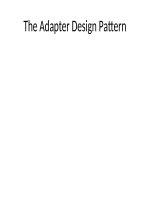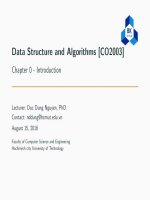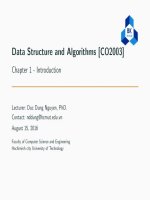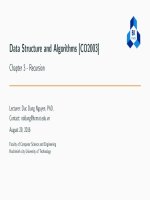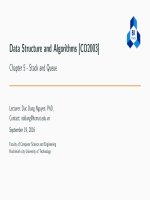C++ programming program design including data structure 7th ch10
Bạn đang xem bản rút gọn của tài liệu. Xem và tải ngay bản đầy đủ của tài liệu tại đây (732.59 KB, 46 trang )
Chapter 10:
Classes and Data Abstraction
Objectives
In this chapter, you will:
– Learn about classes
– Learn about private, protected, and public
members of a class
– Explore how classes are implemented
– Become aware of accessor and mutator functions
– Examine constructors and destructors
C++ Programming: Program Design Including Data Structures, Seventh Edition
2
Objectives (cont’d.)
– Learn about the abstract data type (ADT)
– Explore how classes are used to implement ADTs
– Become aware of the differences between a struct and
a class
– Learn about information hiding
– Explore how information hiding is implemented in C++
– Learn about the static members of a class
C++ Programming: Program Design Including Data Structures, Seventh Edition
3
Classes
• Object-oriented design (OOD): a problem solving
methodology
• Objects: components of a solution
• Class: a collection of a fixed number of components
• Member: a component of a class
C++ Programming: Program Design Including Data Structures, Seventh Edition
4
Classes (cont’d.)
• Class definition:
– Defines a data type; no memory is allocated
– Don’t forget the semicolon after the closing brace
• Syntax:
C++ Programming: Program Design Including Data Structures, Seventh Edition
5
Classes (cont’d.)
• Class member can be a variable or a function
• If a member of a class is a variable
– It is declared like any other variable
– You cannot initialize a variable when you declare it
• If a member of a class is a function
– Function prototype is listed
– Function members can (directly) access any member of the
class
C++ Programming: Program Design Including Data Structures, Seventh Edition
6
Classes (cont’d.)
• Three categories of class members:
– private (default)
• Member cannot be accessed outside the class
– public
• Member is accessible outside the class
– protected
C++ Programming: Program Design Including Data Structures, Seventh Edition
7
Unified Modeling Language
Class Diagrams
• Unified Modeling Language (UML) notation: used to
graphically describe a class and its members
– +: member is public
– -: member is private
– #: member is protected
C++ Programming: Program Design Including Data Structures, Seventh Edition
8
Unified Modeling Language Class
Diagrams (cont’d.)
C++ Programming: Program Design Including Data Structures, Seventh Edition
9
Variable (Object) Declaration
• Once defined, you can declare variables of that
class type
clockType
myClock;
• A class variable is called a class object or class
instance
C++ Programming: Program Design Including Data Structures, Seventh Edition
10
Accessing Class Members
• Once an object is declared, it can access the public
members of the class
• Syntax:
– The dot (.) is the member access operator
• If an object is declared in the definition of a member
function of the class, it can access the public
and private members
C++ Programming: Program Design Including Data Structures, Seventh Edition
11
Built-in Operations on Classes
• Most of C++’s built-in operations do not apply to
classes
– Arithmetic operators cannot be used on class objects
unless the operators are overloaded
– Cannot use relational operators to compare two class
objects for equality
• Built-in operations that are valid for class objects:
– Member access (.)
– Assignment (=)
C++ Programming: Program Design Including Data Structures, Seventh Edition
12
Assignment Operator and Classes
C++ Programming: Program Design Including Data Structures, Seventh Edition
13
Class Scope
• An object can be automatic or static
– Automatic: created when the declaration is reached and
destroyed when the surrounding block is exited
– Static: created when the declaration is reached and
destroyed when the program terminates
• Object has the same scope as other variables
C++ Programming: Program Design Including Data Structures, Seventh Edition
14
Class Scope (cont’d.)
• A member of the class is local to the class
• Can access a class member outside the class by
using the class object name and the member
access operator (.)
C++ Programming: Program Design Including Data Structures, Seventh Edition
15
Functions and Classes
• Objects can be passed as parameters to functions
and returned as function values
• As parameters to functions
– Objects can be passed by value or by reference
• If an object is passed by value
– Contents of data members of the actual parameter are
copied into the corresponding data members of the formal
parameter
C++ Programming: Program Design Including Data Structures, Seventh Edition
16
Reference Parameters and Class
Objects (Variables)
• Passing by value might require a large amount of
storage space and a considerable amount of
computer time to copy the value of the actual
parameter into the formal parameter
• If a variable is passed by reference
– The formal parameter receives only the address of the
actual parameter
C++ Programming: Program Design Including Data Structures, Seventh Edition
17
Reference Parameters and Class
Objects (Variables) (cont’d.)
• Pass by reference is an efficient way to pass a
variable as a parameter
– Problem: when passing by reference, the actual parameter
changes when formal parameter changes
– Solution: use const in the formal parameter declaration
C++ Programming: Program Design Including Data Structures, Seventh Edition
18
Implementation of Member Functions
• Must write the code for functions defined as function
prototypes
• Prototypes are left in the class to keep the class
smaller and to hide the implementation
• To access identifiers local to the class, use the scope
resolution operator ::
C++ Programming: Program Design Including Data Structures, Seventh Edition
19
Implementation of Member Functions
(cont’d.)
C++ Programming: Program Design Including Data Structures, Seventh Edition
20
Implementation of Member Functions
(cont’d.)
C++ Programming: Program Design Including Data Structures, Seventh Edition
21
Implementation of Member Functions
(cont’d.)
• Once a class is properly defined and implemented,
it can be used in a program
– A program that uses/manipulates objects of a class is
called a client of that class
• When you declare objects of the class
clockType, each object has its own copy of the
member variables (hr, min, and sec)
• Called instance variables of the class
– Every object has its own instance of the data
C++ Programming: Program Design Including Data Structures, Seventh Edition
22
Accessor and Mutator Functions
• Accessor function: member function that only
accesses the value(s) of member variable(s)
• Mutator function: member function that modifies
the value(s) of member variable(s)
• Constant function:
– Member function that cannot modify member variables
– Use const in function heading
C++ Programming: Program Design Including Data Structures, Seventh Edition
23
Order of public and private
Members of a Class
• C++ has no fixed order in which to declare public
and private members
• By default, all members of a class are private
• Use the member access specifier public to make a
member available for public access
C++ Programming: Program Design Including Data Structures, Seventh Edition
24
Constructors
• Use constructors to guarantee that member
variables of a class are initialized
• Two types of constructors:
–
–
–
–
With parameters
Without parameters (default constructor)
Name of a constructor = name of the class
A constructor has no type
C++ Programming: Program Design Including Data Structures, Seventh Edition
25

